By Kate Cebik
Development Associate
I believe it is nearly impossible to watch a group of pint-sized beekeepers tromping through the garden paths and not follow them. So, of course, I hurried to catch up and see what was going on.
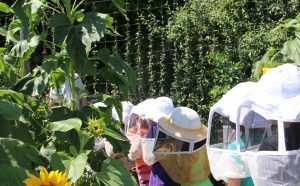
Suited up and ready to check out the hives.
I discovered the campers from Yellow Group–each decked out in a beekeeping hood–trailing behind environmental educator and counselor Tim Dutcher. A faint trail of smoke lingered after them. These campers had the chance to check out the hives with Tim and learn about our bees. We all stood in the field rapt as Tim explained about the hives, carefully smoking the bees to calm them and lifting the boxes so we could see the bees at work.
Tim passed around a bag of propolis–the “bee glue” the bees collect from resins from tree buds like pine. This is different from the wax they use to build the hive, which is actually produced by plates on the bee’s abdomen. The kids lined up for a turn squeezing the smoker and watching each puff dissolve into the air around them.
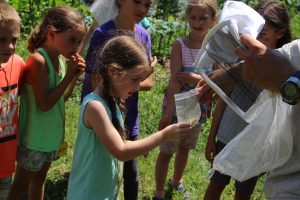
Checking out propolis.
When a camper asked, “Can you catch a bee for us?” Tim offered to find a drone bee, as drone bees doesn’t sting. The kids were delighted by the chance to meet, and even to hold, a bee. They nicknamed their bee mascot Buzz. “Drones looks different from the female worker bees–they have these really big eyes, as you can see. But,” he reminded them, “never try to catch a bee because it takes a lot of practice to know how to recognize one.” They promised not to try this at home.
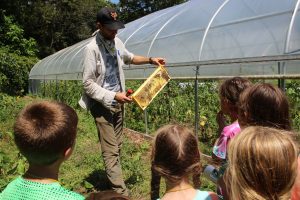
Meeting the bees.
“Bumblebees don’t sting,” one camper proclaimed. “Actually bumblebees can sting,” explained Tim, “but usually we don’t interact with them in a way that could get us stung.”
“How do you get a worker bee or a drone bee?” another camper asked.
“Well,” Tim explained,”another cool thing about bees is that the queen gets to ‘choose’ what kind of bee she’s going to lay. She can lay an unfertilized egg–that becomes a drone–or a fertilized egg, which becomes a worker bee.” Tim later explained to me that a worker bee’s path in life is set in its first days. If it is fed a special diet during this crucial stage, it will grow to become a queen bee. When a queen bee is active in the hive, she releases pheromones that inhibit the ovary development of the other female bees.
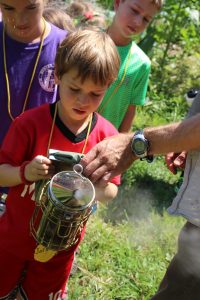
Trying out the smoker.
A queen bee’s pheromones also regulate the population of the hives. When the queen walks along the comb, her feet release a pheromone that tells the other bees that the queen is present. If the hive gets too crowded, the queen ends up walking on other bees instead of on the comb, leaving no pheromone. This triggers a swarm response in the bees, which means a group will exit and find a new hive.
In the fall and winter when the temperatures dip into the 50’s and below, the bees cluster together with the queen at the center. The worker bees vibrate their wing muscles to create heat. They can keep the hive around 80 degrees doing this. The bees on the outer edge of the cluster cycle back in as they get cool.
After exploring the hives, Tim and the kids headed inside for some honey harvest, a favorite part of the day. Campers scrape along the comb to remove the honey, and are rewarded with sweet samples (from their fingers and from cups).
Tim got into beekeeping while in college. “I was hunched over from too much reading, and I wanted some physical work,” he explained. His mother connected him with a farm in Wisconsin. During his time there, he spent a day with a beekeeper.
The first time I walked into the bee yard and heard the noise…the physical presence there went to my bones, and I was like, this is for me.
Tim describes how quickly he felt drawn to this work. When he returned to Connecticut he wanted to figure out a way to get hives of his own.
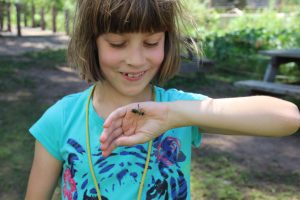
“Buzz” hangs out with a new friend.
“Then I realized that colleges love to pay for stuff if you have a plan and ask them, so I got Wesleyan to get a garden going–complete with hives.” This is now the Wesleyan Farm. Tim kept bees there from 2001-2007. He now operates nine hives around Connecticut.
When asked him how one goes about setting up a hive, he laughed. “The running gag is if you ask three beekeepers the same question, you’ll get eight different answers.” So, while it’s safe to say that there are many methods, Tim distilled his methods down to the basics for me:
- Set up the physical structure of the hive.
- Get a box of bees (shipped/trucked) and dump the bees into the hive.
- As a beekeeper, your jobs are: manage their growth, watch their food supplies and stores, see that they are producing wax to build, that the queen is laying, and the population is growing. As the boxes fill, you add more boxes.
- The honey belongs to the bees first, so you have to be sure they have enough to sustain the hive. For example, we leave two boxes of honey for them and harvest the excess.
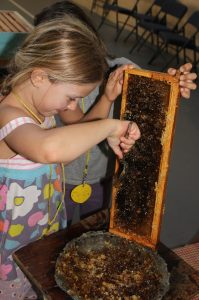
Harvesting honey from the honeycomb.
If you are interested in beekeeping, Tim suggests you check out the NOFA workshops, meet other beekeepers, and read books on beekeeping. Of course, that’s just his method–if you ask another beekeeper….
This season alone, Common Ground harvested about 150 pounds of honey (five gallons harvested this week!) Tim says it’s reasonable to expect about 100 pounds of honey per year per hive, though one could get 200 or even more. Those of us fortunate enough to be at our Farm Stand Extravaganza this week had the chance to purchase some of Tim’s Trendsetter Labs honey –delicious! If you are looking to get a taste of something sweet, you can contact Tim with your honey requests or bee questions at tdutcher@wesleyan.edu or comment below.

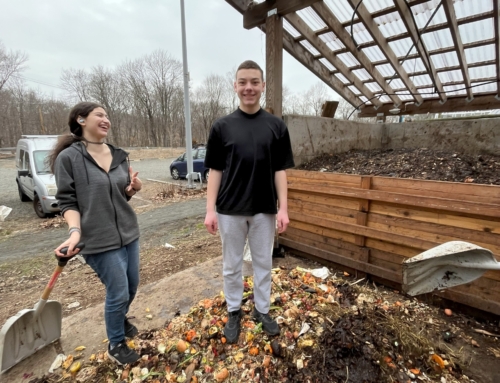
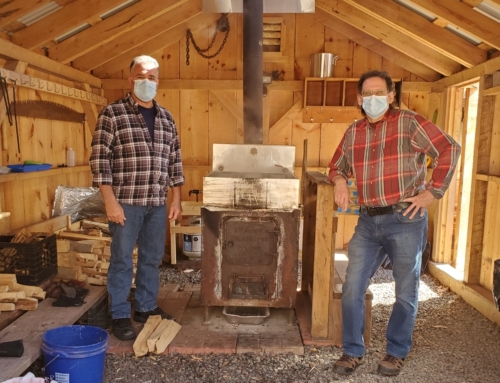
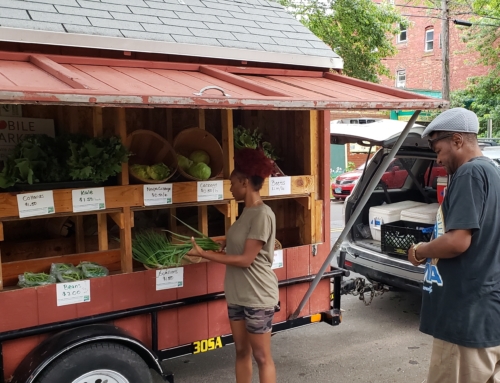
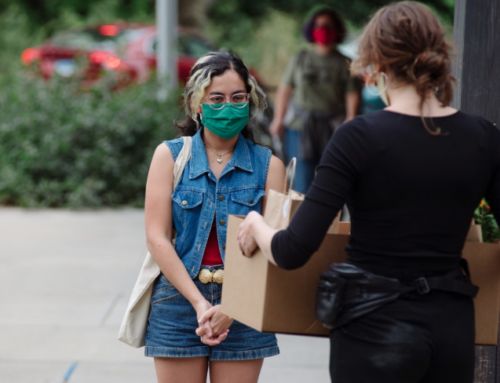
Hello Tim,
I am currently looking for a COOP opportunity to pair up with a local venue in order to keep bee’s utilize honey.
I am the Executive Chef at the Omni here in New Haven and have had some experience with beekeeping with our property in Amelia Island Florida where we totaled out before my departure at 8 hives and still growing. It was definitely a very exciting opportunity and we were self taught and sure there is a lot of room to grow and learn.
I most recently have purchased 3 hives and as much of the equipment that I could squeeze in before the end of the year, but have yet to have the time to find a close local farmer or organization that is willing to partner up with us.
When you have a moment please reach, phone number is 832-723-1043 or by email.
Thanks,
Todd Ruiz
Executive Chef
Omni New Haven Hotel at Yale
203-974-6735direct
todd.ruiz@omnihotels.com
Hi Todd, thanks for your note. I have forwarded this message along to Tim at tdutcher@wesleyan.edu. He is currently traveling but should be back in the area soon!